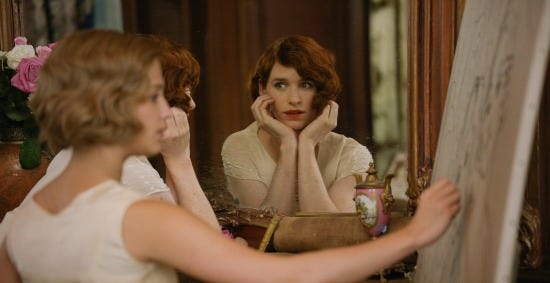The Danish Girl

“The Danish Girl” is the true-ish story of Einar Wegener, a well-known Danish painter who became a woman in the early 20th century. Today we would refer to this as a transwoman “transitioning” to her true gender, and use her adopted name, Lili Elbe, and the appropriate pronouns.
But the film is less about conforming to modern-day sensibilities than presenting Lili/Einar as she/he was — a gentle soul confused about the journey being undertaken, but who steadily gains strength and resolve as the challenges grow.
Directed by Tom Hooper (“The King’s Speech”) from a screenplay by Lucinda Coxon, based on the historical novel by David Ebershoff, “The Danish Girl” powerfully shows what it was like to question one’s gender at a time and place when such roles were rigidly defined and enforced. Eddie Redmayne, last year’s Oscar winner for Best Actor, is sure to pick up another nomination for his nuanced turn.
The story opens with Einar married to Gerda Wegener. Both young painters with a carefree lifestyle and a strong desire for children, they live rather unequal lives. Einar is feted at gallery shows, celebrated by powerful patrons, while she toils in his shadow. It’s puzzling, since he — by his own admission — essentially paints the same thing over and over: pastoral scenes from his drab, lonely childhood.
Gerda (Alicia Vikander, vibrant and emotive) plays Einar’s wife, who actually kick-starts his journey by asking him to don some hose and shoes so she can finish her painting after her (female) model takes ill. Einar finds himself ensorcelled by the look and feel of women’s clothing. The couple playfully continues the game, going to a party with Einar dressed as his cousin, “Lili.” She even attracts the attention of a discerning young man (Ben Whishaw), who pitches woo.
Soon, though, Einar is spending more and more time as Lili, studying the mannerisms of the fair gender and copying them — even to the point of exaggeration. Lili is easily the most girlish woman in any room she occupies. Redmayne is convincingly coquettish and shy, showing how just because a person’s outward identity changes, the inner soul doesn’t. Since Einar was something of a blushing wallflower, Lili is, too.
Things go on from there. There are marriage troubles as Gerda grows distraught about “losing” her husband. She enlists Einar’s old childhood friend, Hans (Matthias Schoenaerts), on whom he had a boyhood crush, to act as a touchstone. But Gerda ends up developing feelings for him herself.
Doctors of the time are no help, subjecting Einar to radiation treatments that leave him bedridden, then reporting him to the authorities as a deviant when their barbaric procedures bring no result.
There are, of course, many liberties taken with Lili’s story, which flow from Ebershoff’s fictionalized portrait of her. The main one is showing her struggling with her surgical transformation more or less in private, when in fact it was quite a renowned feat at the time. Her autobiography, published two years after her death, was a watershed moment in the transgender movement.
It also depicts Gerda as staying by her side throughout this process and her demise, when in fact their marriage was legally dissolved as a result of Lili’s gender change, and Gerda had moved on to other romantic partners. (She was not even present at the death, hearing about it through the news.)
Still, this falls under the filmmaking rubric of "lying in order to tell a greater truth," as we saw in the excellent “Steve Jobs” earlier this year. “The Danish Girl” may skirt the historical facts, but it still has the compelling illumination of trueness.



